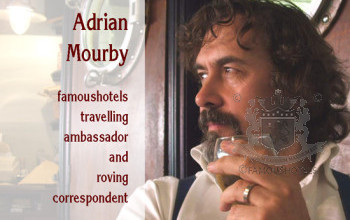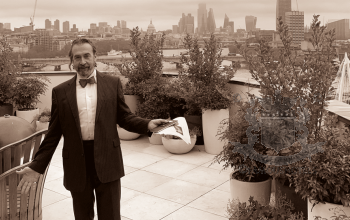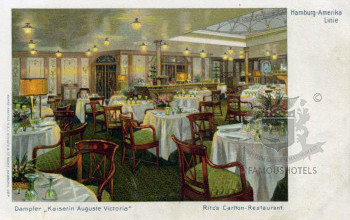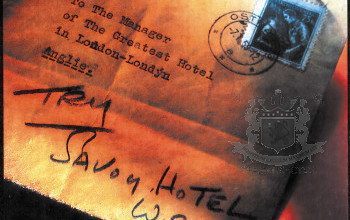A Palace on the Strand
( words)

In 1900 visitors to London were advised by Baedeker to find a hotel on the Strand. The choice began with 700-room Hotel Cecil, built on the site of Lord Cecil’s Thameside home, then the Savoy (built by Richard D’Oyly Carte who produced the Gilbert & Sullivan operettas), and finally the Charing Cross Hotel, a 350-room mansion immediately above the famous railway station.
One hotel that was not explicitly recommended stood immediately opposite the Cecil. Haxell’s Family Hotel was a more modest three-storey proposition. It occupied two buildings either side of the neo-classical entrance to Exeter Hall. But Exeter Hall was famous all around the English-speaking world in the nineteenth century as a meeting place where great issues of the day were discussed. The establishment of a free colony of South Australia was first mooted here in 1834, and the British anti-slavery movement pretty much began in the hall’s 4,000-seat main auditorium. Hector Berlioz on his visits to London in 1852 and 1855 conducted concerts in Exeter Hall.
By 1900 however this big old venue was in need of repair, and it was obvious that the site could be put to a much more lucrative use. In 1907 the Strand Hotel Limited Company was founded by the Salmon and Gluckstein families, German Jewish tobacco importers who had settled in London’s East End. They bought and demolished Exeter Hall in order to build an imposing new hotel, “Strand Palace”, which opened in 1909.

The year 1909 was a good one for hotels. The Astoria Hotel in Brussels (now the Corinthia Grand Hotel Astoria), Hamburg’s Hotel Atlantic (now the Hotel Atlantic Kempinski) and the Hotel Victoria in Toronto all opened that year. The new Strand Palace retained Exeter Hall’s old imposing entrance and even added some Art Nouveau flourishes to its roofline but it had one problem. The two wings of Haxell’s Family Hotel were still connected by a corridor that had run through Exeter Hall and now ran through the brand-new Strand Palace Hotel. This anomaly was finally dealt with in 1922 when J. Lyons & Co, the famous British coffee house company (a subsidiary of Salmon & Gluckstein) bought the two Haxells hotels to merge all three buildings and create one hotel the size of a city block.
The resulting hotel was indeed huge. By the time it was completed in 1928 the new Strand Palace had 980 bedrooms grouped around six inner courtyards. This made it bigger than the 700-room Cecil but – unlike the forward-looking Savoy - most of the Strand’s bedrooms were without private baths.
The evolution of Strand Palace hadn’t finished yet however. In the 1930s Lyons assigned its chief architect, Oliver Percy Bernard, to refurbish the hotel in the Art Deco style that was proving popular at high-profile hotels like the Dorchester and Claridges. Bernard created such a remarkable interior that when the hotel’s pink marble lobby, with its translucent moulded glass balustrades and chromed steel columns, was being ripped out in an unfortunate 1960s modernisation the Victoria & Albert Museum bought it in its entirety. It was subsequently reconstructed at the museum for a major retrospective on British Art Deco.
During World War II this massive hotel was commissioned as an official rest and recuperation base for American troops in London, but in 1958 its number of rooms was reduced to 785 when private bathrooms were added to every bedroom.
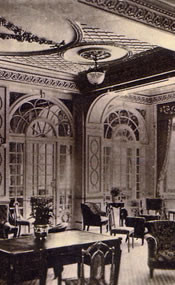 Today the hotel’s main entrance is still through the archway that led to Exeter Hall and later to the Art Deco lobby of Oliver Percy Bernard. You have to look carefully at the façade however to make out the lines of the old archway as the major rebuilding of 1922-28 created a seamless stone façade fronting on to the Strand. A recent 21st century refurbishment has however reintroduced some Art Deco touches in a nod to Bernard. The 785 almost identical bedrooms now have 1930s-style wooden shutters and low Art Deco armchairs. Room numbers are spelled out in a metal geometric typeface all the way down the long dark brown corridors. One feature that has remained untouched – even by Bernard’s Art Deco revamp – is the main staircase that was constructed in the 1920s when the original Strand Palace and the two Haxell hotels were merged. This monumental staircase has ornate brass balustrading and rises up all nine floors although it is tucked away towards the back of the hotel as by 1928 guests would be expecting to take elevators from the lobby.
Today the hotel’s main entrance is still through the archway that led to Exeter Hall and later to the Art Deco lobby of Oliver Percy Bernard. You have to look carefully at the façade however to make out the lines of the old archway as the major rebuilding of 1922-28 created a seamless stone façade fronting on to the Strand. A recent 21st century refurbishment has however reintroduced some Art Deco touches in a nod to Bernard. The 785 almost identical bedrooms now have 1930s-style wooden shutters and low Art Deco armchairs. Room numbers are spelled out in a metal geometric typeface all the way down the long dark brown corridors. One feature that has remained untouched – even by Bernard’s Art Deco revamp – is the main staircase that was constructed in the 1920s when the original Strand Palace and the two Haxell hotels were merged. This monumental staircase has ornate brass balustrading and rises up all nine floors although it is tucked away towards the back of the hotel as by 1928 guests would be expecting to take elevators from the lobby.
Another nod to the past is the hotel’s restaurant, a new construction opposite reception that bears the name of Haxells. It’s a nice touch that the modest family hotel with its two halves connected through the Strand Palace Hotel of 1908 lives on in that name.
Sadly Hotel Cecil, which Baedeker urged on visitors to London in 1900, was demolished in 1930 but its façade remains gazing across to Strand Palace Hotel. Behind the façade where was once a grand courtyard for guests to park their cars stands the office of Penguin Random House, publishers of Lonely Planet and the Dorling Kindersley Travel Guides, the Baedekers of the twenty-first century.
ENDS


